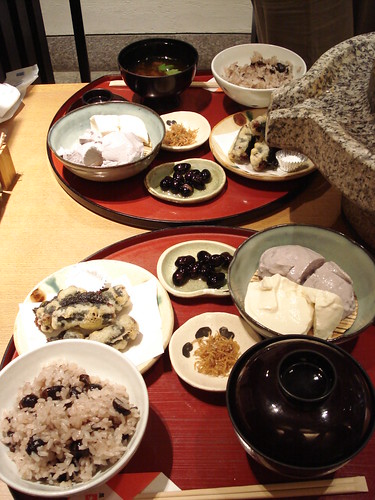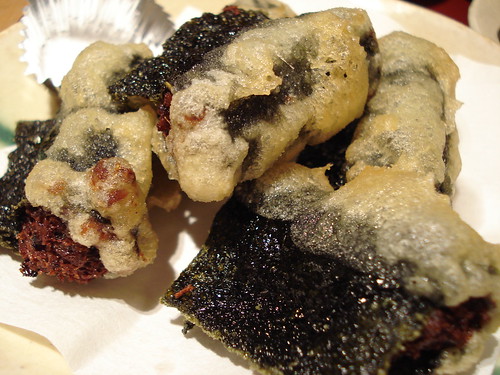Vegetarian Okonomiyaki

Okonomiyaki is a typical festival food in Japan - at every Omatsuri you can be sure to find at least one or two okonomiyaki stalls (except for the Namaste India festival and the Vegetarian Culture Fair maybe..). Osaka is famous for this dish that consist mainly of shredded cabbage and a pancake-like batter, spiced up with beni shôga, pickled red ginger, all fried on a hot plate and topped with a special dark brown sauce and oftentimes mayonnaise. The version from Hiroshima contains fried soba and the ingrediences are not mixed up, but first the batter is fried to something like a pancake and than the other ingrediences are all piled up on it to one tower of okonomiyaki that shrinks during the frying but it still looks like an artistic feat to turn it over..
Unfortunatly the usual okonomiyaki is not vegetarian, but made with fish-based dashi (stock), often with those tiny kind of shrimps and topped with my friends the katsuobushi (fishflakes)..
Actually it would be no problem to leave those little beasts out, but as it often is in Japan you make people very uneasy if you ask to modify a traditional, original, century old recipe even the slightest little bit. It seems to be a sacrilege, impossible because the dish is just perfect as it is - I don't dare to doubt that, but I prefer an imperfect veggie dish to a perfect one with dead animals in it. Usually it still tastes great and for me personally it tastes better when there are no little sad eyes staring at me from my plate!
But it seems like there is no way to make it any different, although the name okonomiyaki implies "fry whatever you want"... Well, yet there is a way: just do it yourself! A few days ago I was invited for a fantastic, homemade, vegetarian okonomiyaki and monja dinner - and a feast it was! Monja (also called monjayaki) is the softer, more liquid and mushy sister of okonomiyaki - a dish originating from Tokyo, to be eaten directly from the hot plate it is fried on, for example in one of the countless monja places in shitamachi. There you also should be able to find veggie versions, but it is also easy to make it at home - you only need a hot plate. There are special ones for okonomiyaki (and monja), but I think it should also work on those hot plates on top of raclette ovens, maybe even in a good not-sticking pan. Although making it in a pan is not an ideal solution, cause the sociable, comfortable and fun aspect of sitting around the hot plate waiting for the next piece of food and watching the batter sizzle. You can easily spent two hours eating like that - nice!
Now to the recipes. I don't know exact measurements, but I think it is a dish that does not require exact measurements. Just try to fry one okonomiyaki and if it is too soggy add some more flour before you fry the next one or add more stock if you think it is too dry - easy as that.
Okonomiyaki:
Cut about half of a cabbage in thin slices.
Mix about 3 cups of flour with 1-2 eggs and some veggie stock (less than 1 cup should be enough), add a little salt.
Mix the cabbage and the batter and add as much beni shôga as you like (don't take too much, otherwise you won't taste anything else anymore).
Now you can add whatever you like, for example: thinly sliced shiitake, okra, green asparagus, onions or leek, pieces of mochi (sticky not-sweetened ricecakes), corn, even cheese is not unusual and tastes fantastic with it.. Our okonomiyaki-host also added Agedama (also called Tenkasu), that is something resembling the German "Backerbsen" (are they called soup pearls in English? Until that night I didn't know they exist outside of Germany).
Than fry a big spoon of it on the hot plate with very little oil and turn it over when it is still soft on top but golden brown on the underside and fry it on the other side for a short time. 
Afterwards top it with a thick and sweet soy sauce (since okonomiyaki sauce is usually with oyster extract and worcestershire sauce, that resembles it a lot contains anchovies as far as I know), mayonnaise (if you like it - I hate mayonnaise so I don't use it), sprinkle with aonori (dried seaweed). Part it in four pieces with a wooden spatula and serve hot. While eating the next serving is put on the hot plate.
For making monja you make the same batter, just add much more water or veggie stock and grated yam and stir it a bit longer. Then put the cabbage and whatever you want to have with it (I recommend asparagus and cheese) on the hot plate and let it stir-fry for a moment, make a hole in the middle and add the batter. Then everyone spreads out bitsized pieces of it thinly with a wooden spatula, so that those pieces become brown, a bit gumlike and crispy on the edges - these portions are to be eaten directly from the hot plate with chopsticks. Here and here you can see pictures of monja.
Have a nice meal, share it with friends and enjoy a great foody-night, like I did - thanks again Nishi-san and Yuko-san :)







